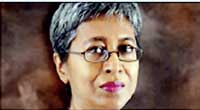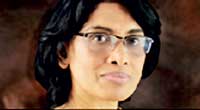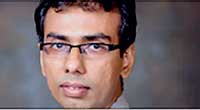Saturday Mar 01, 2025
Saturday Mar 01, 2025
Tuesday, 16 November 2021 02:27 - - {{hitsCtrl.values.hits}}
Dr. Dushni Weerakoon

Budget 2022 appears to be more of a stop-gap budget rather than one that sets out a framework on how revenues will continue to be mobilised and deficit financing requirements met over time.
It seems that the Government is hedging its bets on economic growth creating revenues, but with inflation set to rise in the coming months, and Government fiscal financing from the banking sector largely set to be even higher at 2.7% of GDP compared to 2.2% of GDP in 2021, this is calling for monetary authorities to step in with higher interest rates.
It will threaten the forecasted growth, weaken tax revenue, and leave less room for investment. In the face of the fiscal stresses, it would have made sense to make structural changes to our tax system and ask for greater sacrifices from those with more ability to pay.
Dr. Nisha Arunatilake
Labour: The Budget focuses on rural development by allocating Rs. 19,894 million to 335 Divisional Secretariat divisions to commence rural livelihood development programs. The Budget has also allocated other funds aimed at reviving the rural economy. For example, Rs. 5,000 m for developing small and medium-scale industries, Rs. 5,000 m for modernising agriculture, and Rs. 5,000 m for improving infrastructure in product investment zones. Many other countries in the world are also making public investments to help the post-COVID-19 recovery process and create jobs. This could be a potentially good investment if money is spent according to well researched strategic plans to help revive the rural economy.
Education: The Budget proposes to reduce district level disparities in education facilities by giving the required land and tax concessions for the establishment of international schools in every district. This proposal assumes that privately provided education will result in better facilities, but this is not necessarily true. However, the Budget proposes investments for improving rural schools with better facilities and a more diverse subject stream. Additional funding of Rs. 5,300 m for expediting the establishment of 1,000 national schools is also proposed. The latter two proposals are more likely to help reduce the disparities in access to quality education. Nevertheless, the emphasis should not only be on reducing disparities in the availability of facilities but the outcome of education. IPS research shows that disparities in teacher quality and availability is a key factor causing disparities in education outcomes. Investments are needed in teacher training, professionalising of the teacher service, and proper allocation of teachers to schools to alleviate this problem. Schools were partially or fully closed for almost 20 months since the COVID-19 pandemic started. This has resulted in learning losses. Some Budget allocations assessing learning losses and taking remedial action to help catch up would have been good.
Dr. Ganga Tilakaratna 
Social welfare: Budget 2022 has proposed reforms to the Samurdhi program – (1) to transform it as a rural development movement to ensure economic revival and food security without just confining it to a poor-relief program and (2) to select Samurdhi beneficiaries using a rational and scientific mechanism. The second proposal is necessary to minimise the prevailing exclusion and inclusion errors as well as to reduce the rising budget of the Samurdhi cash transfer program. The Budget has also proposed to establish a contributory pension scheme for senior citizens who do not currently receive pensions. This is an important step to ensure income security of the ageing population, particularly the informal sector workers. However, when designing such a contributory scheme, it is important to take into account the nature of the income of informal sector workers and their capacity to contribute to a pension scheme at regular intervals.
Dr. Bilesha Weeraratne 
Migrant workers: Budget 2022 contains two proposals on remittances and migrant workers. For migrant workers, the proposal is to provide training and other facilitation to increase departures. There should have also been some support to recruitment agents because they also depend on workers, and in the absence of workers going for new jobs, they are also affected. The Budget could have taken care of them also at this critical juncture. The Budget also aims to increase remittances to about $ 6.8 b. This is an ambitious target. In the first three quarters of 2021, we received about $ 4.5 b. During September, remittances went down drastically to about $ 350 m, which is almost half of what we got in September 2020. More than the pandemic, there were forex concerns in the country so when the banking sector was exchanging USD at Rs. 198-202, the authorised money dealers outside were paying about Rs. 235-240 per USD. This gap encouraged many people to hand carry money and exchange from the authorised money changers. This was an incentive for informal remittances and a similar trend would also follow in October 2021. Therefore, it might not be easy to achieve this target.
Dr. Manoj Thibbotuwawa
Agriculture: The Government has decided to invest substantially in the Triple-A Economy (Agriculture, Aquaculture, and Animal Husbandry) considering the importance of these sectors to ensure food security and rural income amidst the pandemic. The Budget has proposed to provide a grant of Rs. 5,000/ha for using non-toxic weedicides and allocated Rs. 35,000 m to provide start-up working capital to produce solid and liquid fertilisers, and organic pesticides. While this was expected with the recent ban of chemical fertiliser and agrochemicals, there are no provisions for R&D, extension, and certification for organic agriculture. Further, the Budget proposes to allocate Rs. 22,005 million for the introduction of new agro-technologies. No provisions have been made to address poor access to quality seed, climate disasters, animal damages to crops, and marketing issues which were correctly identified as major challenges in the Budget speech. Plantation sector priorities have been replanting/gap filling/new plantations, increasing water supply, and encouraging private investment to increase foreign exchange earnings. There is a proposal to introduce new laws on the usage of lands owned by plantation companies. This must be done in consultation with all the stakeholders to minimise the negative impact on the industry. Provisions have been made to expand facilities for marine fishing and releasing fingerlings into freshwater reservoirs to encourage the production of processed fish, dried fish, Maldive fish and canned fish.
Dr. Asanka Wijesinghe 
Trade: The Budget identifies that the overreliance on trade has increased Sri Lanka’s vulnerability and the need for a manufacturing-based economy. It mainly identifies textiles and apparel, value-added tea, coconut products, seafood, spices, and electrical and electronics manufacturing, among many other sectors that have export potential. Plans to remove restrictions on raw materials for electronics manufacturing are welcome moves as the sector has shown robust growth in recent years. However, the expressed overemphasis on import substitution, especially organic agriculture, milk, sugar, and medicine in the Budget should be revisited. Historical and external evidence shows import substitution was not a possible growth strategy given less factor endowment and a small consumer base. Trade policy measures that will bias incentives to domestic production will result in domestic consumer-oriented production instead of needed export-oriented production. In addition, substitution of chemical fertiliser from domestic organic fertiliser might generate adverse effects on traditional exports like tea, aggravating the external sector issues. The Budget has suggested measures to simplify tariff schedules and remove hurdles in clearing imports which should be commended.
Dr. Erandathie Pathiraja
Energy: The Government seeks to be in line with the global movement towards renewable energy sources and expects to fulfil 70% of the energy demand from renewables by 2030 to save foreign currency and reduce import dependence. Potential energy sources are wind, ocean waves and solar for which Sri Lanka can produce and export green hydrogen from the surplus of renewable energy. Attention is paid to electric three-wheelers and motor cars to reduce dependency on fossil fuels. Proposals to use renewable energy sources for street lighting by local Government agencies and reduce the fuel allowance for Government officials by 5L and electricity consumption by 10% are commendable. The proposal to become Asia’s energy hub is welcome to leverage on the country’s strategic position for employment generation and export earnings from value addition.
Priyanka Jayawardena
Health: The Budget recognises the importance of improving the nutritional requirements of both baby and the mother. It proposes to extend the provision of the nutrition basket for pregnant mothers for 24 months. IPS research shows the importance of improving targeted maternal and child nutrition programs to address the malnutrition issue. Given the current pandemic, the extension of pregnant mothers’ food assistance program is an especially welcome move. In line with Government policy, last year’s Budget recognised the importance of improving health services to effectively safeguard people from pandemics and non-communicable diseases (NCDs). Budget 2022 also proposes to allocate Rs. 5,000 m in addition to the already allocated Rs. 32,650 m to improve rural hospitals, dispensaries, maternal clinics, etc. Further, this Budget proposes to facilitate the private sector to produce medicines in Sri Lanka targeting the international market. This is an encouraging move to be more self-sufficient in pharmaceutical products and to save foreign exchange outflows.
Sunimalee Madurawala
Public Services: The ‘Water for All’ program aims to accelerate the major water schemes to ensure the supply of uninterrupted, clean drinking water and to reach the target of fulfilling 90% the clean drinking water demand by the end of 2024. The ‘Electricity for All’ program focuses on the development of renewable energy in line with the national and international development policies. Money is allocated to encourage private investments in the renewable energy sector. On the question of transport, attention is given to improve the services provided by the main institutes in the transport sector: the National Transport Commission, Department of Motor Traffic, Sri Lanka Transport Board and Sri Lanka Railways. Proposals on developing Sri Lanka as a naval hub and an aviation hub are also presented in Budget 2022. All these proposals are commendable steps to develop the water, electricity, and transport sectors of the country and addressing the prevailing issues in those sectors. However, it is important to make sure these programs are implemented properly to meet the intended objectives.
Dilani Hirimuthugodage
SMEs: The Budget recognises the importance of traditional cottage industries to the economy especially during the pandemic recovery period. This was highlighted in the report produced by the IPS for the British Council of Sri Lanka on Mapping Creative and Cultural Industries in Sri Lanka. Developing traditional creative industries is linked to the protection of Intellectual Property Rights (IPRs). A recent IPS article focused on several IP rights available in Sri Lanka to protect traditional creative artisans. Moreover, as the Budget suggests, the development of industry clusters is necessary to develop Geographical Indication (GI) protection systems for traditional creative industries.
Harini Weerasekera 
Taxation: Budget 2022 states that an online-managed single Special Goods and Service Tax (GST), which was proposed in Budget 2021, will now be implemented in January 2022. This GST will replace the various goods and service taxes that are currently imposed under different acts and administrations on cigarettes, alcohol, vehicles, telecommunications, and betting and gaming. While efforts to simplify and digitise taxes are commendable, it seems as though this move will simplify tax collection to some extent but will not necessarily simplify the complex tax bands seen within each of these products. For example, cigarettes are taxed under five bands based on length.
Although a Rs. 5 increase on all tax bands was proposed in this Budget, the “simplification” of this complex cigarette taxing structure is not seen. This implies that this move will be more of an administrative simplification with one institution collecting taxes from the GST, rather than a simplification of the tax structure. But we will have more information when the Act is made public.
Discover Kapruka, the leading online shopping platform in Sri Lanka, where you can conveniently send Gifts and Flowers to your loved ones for any event including Valentine ’s Day. Explore a wide range of popular Shopping Categories on Kapruka, including Toys, Groceries, Electronics, Birthday Cakes, Fruits, Chocolates, Flower Bouquets, Clothing, Watches, Lingerie, Gift Sets and Jewellery. Also if you’re interested in selling with Kapruka, Partner Central by Kapruka is the best solution to start with. Moreover, through Kapruka Global Shop, you can also enjoy the convenience of purchasing products from renowned platforms like Amazon and eBay and have them delivered to Sri Lanka.
Discover Kapruka, the leading online shopping platform in Sri Lanka, where you can conveniently send Gifts and Flowers to your loved ones for any event including Valentine ’s Day. Explore a wide range of popular Shopping Categories on Kapruka, including Toys, Groceries, Electronics, Birthday Cakes, Fruits, Chocolates, Flower Bouquets, Clothing, Watches, Lingerie, Gift Sets and Jewellery. Also if you’re interested in selling with Kapruka, Partner Central by Kapruka is the best solution to start with. Moreover, through Kapruka Global Shop, you can also enjoy the convenience of purchasing products from renowned platforms like Amazon and eBay and have them delivered to Sri Lanka.